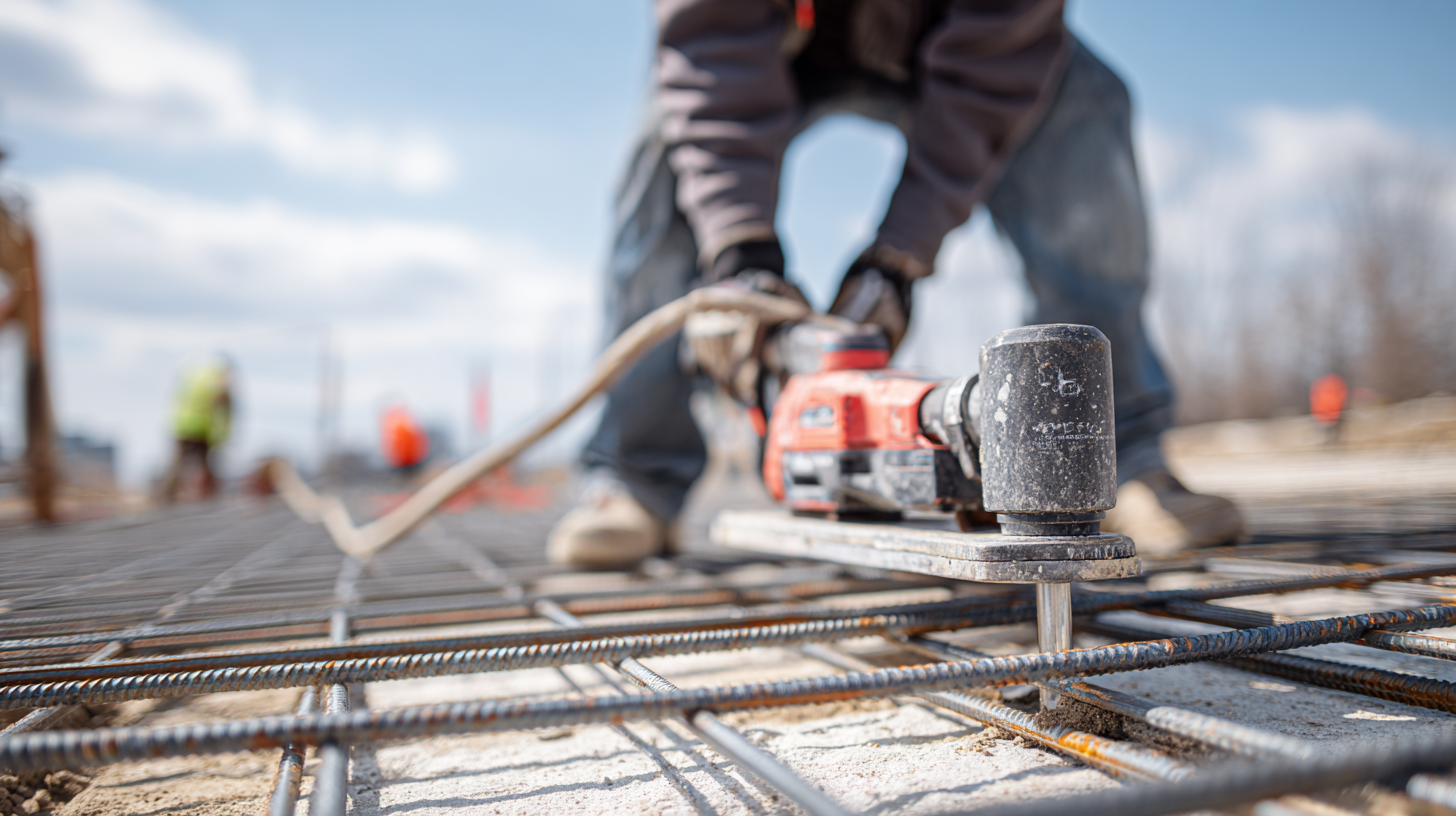
 E-mail:
voyage@voyagehndr.com
E-mail:
voyage@voyagehndr.com

BLOG
Revolutionizing Construction: How Stand Up Rebar Tying Tools Enhance Efficiency and Safety
In the construction industry, efficiency and safety are paramount, particularly when it comes to rebar tying, which is a critical process in reinforcing concrete structures. Traditional rebar tying methods often lead to worker fatigue and increased injury risks, underscoring the need for innovative solutions. According to a recent industry report by MarketsandMarkets, the global construction tools market is expected to reach $130 billion by 2025, driven by the demand for enhanced productivity and safety measures.
 One such innovation is the Stand Up Rebar Tying Tool, which not only minimizes physical strain on workers but also streamlines the tying process. With this tool, construction professionals can complete tasks 2-3 times faster than manual tying methods while reducing the potential for injuries due to awkward postures and repetitive motions. As construction projects become increasingly complex, the adoption of specialized tools like the Stand Up Rebar Tying Tool is essential for maintaining high standards of efficiency and safety.
One such innovation is the Stand Up Rebar Tying Tool, which not only minimizes physical strain on workers but also streamlines the tying process. With this tool, construction professionals can complete tasks 2-3 times faster than manual tying methods while reducing the potential for injuries due to awkward postures and repetitive motions. As construction projects become increasingly complex, the adoption of specialized tools like the Stand Up Rebar Tying Tool is essential for maintaining high standards of efficiency and safety.
The Evolution of Rebar Tying Techniques in Modern Construction
The evolution of rebar tying techniques in modern construction has dramatically transformed the industry, enhancing both efficiency and safety. Traditionally, rebar tying involved manual methods that were not only time-consuming but also required significant physical effort, leading to potential safety risks for workers. Recent advancements have introduced stand up rebar tying tools, which allow operators to work from an upright position, drastically reducing the strain associated with repetitive bending and awkward postures. According to a report by the Associated General Contractors of America, using these tools can improve productivity by up to 30% while minimizing workplace injuries, making them a crucial addition to any modern construction site.
In addition to improving efficiency, stand up rebar tying tools contribute to better ergonomics on the job. Workers can maintain proper body alignment and reduce fatigue, enabling them to work for longer periods without discomfort. A study by the National Institute for Occupational Safety and Health highlights that ergonomic tools can decrease musculoskeletal disorders among construction workers by nearly 50%. Emphasizing the importance of worker well-being, construction companies are increasingly adopting these tools to foster a safer work environment.
**Tips for Implementing Stand Up Rebar Tying Tools:**
1. Train your team in the proper use of these tools to ensure maximum efficiency and minimize safety risks.
2. Regularly maintain the tools to ensure they operate smoothly and effectively, preventing downtime on the job site.
3. Encourage feedback from workers about their experiences with these tools to continuously improve safety practices and operational efficiency.
Revolutionizing Construction: How Stand Up Rebar Tying Tools Enhance Efficiency and Safety
| Technique | Efficiency Gain (%) | Safety Improvement (%) | Ergonomic Benefits | Training Time (Hours) |
|---|---|---|---|---|
| Manual Tying | 0% | Baseline | Standard | 12 |
| Stand Up Tying Tool | 30% | 40% | High | 4 |
| Automatic Tying Machine | 50% | 60% | Very High | 2 |
Benefits of Stand Up Rebar Tying Tools for Worker Safety
Stand up rebar tying tools are transforming the construction industry by significantly enhancing worker safety. Traditionally, tying rebar required workers to kneel or bend down for extended periods, leading to physical strain and a higher risk of injuries. With stand up rebar tying tools, workers can perform their tasks while standing, which reduces the likelihood of musculoskeletal injuries. This ergonomic advantage allows for a more comfortable working environment, promoting better posture and minimizing fatigue throughout the workday.
In addition to reducing physical strain, these tools also improve overall site safety. By enabling workers to tie rebar from a standing position, they can maintain better visibility of their environment, allowing them to identify potential hazards more effectively. This heightened awareness reduces the risk of accidents, making job sites safer for everyone involved. Furthermore, the increased efficiency of these tools means workers can complete their tasks more quickly, reducing the time they spend in potentially hazardous positions. As a result, adopting stand up rebar tying tools not only enhances productivity but also prioritizes the health and safety of construction workers.
Efficiency Gains through Ergonomic Design and Technology
The construction industry has long grappled with the challenges posed by manual labor, particularly in rebar tying—a task often associated with repetitive strain injuries and inefficiency. However, the advent of stand-up rebar tying tools signifies a transformative shift. With an ergonomic design at the forefront, these tools prioritize the health and well-being of workers while enhancing productivity. By allowing users to work in a standing position, they reduce the risk of back pain and other musculoskeletal issues that can arise from bending and kneeling for prolonged periods.
Incorporating advanced technology, such as battery-powered mechanisms and intuitive controls, stand-up rebar tying tools streamline the tying process. They not only facilitate faster workflows but also minimize the physical toll on construction workers. This combination of ergonomic innovations and technological advancements results in significant efficiency gains, allowing projects to meet tight deadlines without compromising safety. As more construction companies adopt these tools, the potential for improved working conditions and increased output becomes clear, paving the way for a safer, more efficient future in the industry.

Comparative Analysis: Traditional vs. Stand Up Rebar Tying Methods
The construction industry is undergoing a significant transformation with the introduction of stand-up rebar tying tools, which markedly enhance both efficiency and safety compared to traditional methods. A comparative analysis reveals that traditional rebar tying methods often involve manual tying at ground level, which can be time-consuming and labor-intensive. According to a report by the National Safety Council, approximately 15% of all construction injuries are attributed to improper handling of rebar. In contrast, stand-up rebar tying tools allow workers to tie rebar more easily while standing, significantly reducing the strain on their bodies and limiting their exposure to hazards.

Tips: When choosing a stand-up rebar tying tool, consider the weight and ergonomics of the tool to ensure that it meets your team’s needs. It's essential to invest in training sessions for workers to maximize the tool's benefits and to minimize the risk of injury on-site.
Moreover, studies indicate that using these advanced tools can increase productivity by up to 50%. This leap in efficiency not only translates to faster project completion but also allows teams to allocate their resources more effectively. Field data suggests that projects utilizing stand-up rebar tying tools experience a notable decrease in labor costs, improving overall profitability for contractors.
Future Trends in Construction Tools: Beyond Rebar Tying Solutions
The construction industry is witnessing a transformative shift with innovations in tools that enhance efficiency and safety beyond traditional solutions like rebar tying. According to a recent report by MarketsandMarkets, the global construction tools market is projected to reach $64.9 billion by 2026, expanding at a compounded annual growth rate (CAGR) of 5.9%. This growth is fueled by the increasing demand for advanced tools that facilitate faster project completion and minimize labor costs, highlighting a trend towards automation and improved ergonomic designs in construction equipment.
Moreover, as the industry embraces technology, emerging trends such as the integration of IoT and smart technologies are set to revolutionize the way construction tools are utilized. For instance, tools equipped with sensors can provide real-time data on usage and performance, allowing teams to optimize workflows and enhance safety protocols. The National Institute for Occupational Safety and Health (NIOSH) reports that implementing advanced safety technologies can reduce workplace injuries by up to 25%, which underscores the critical role of innovating beyond basic rebar tying solutions. As we move forward, the construction industry will undoubtedly harness these advancements to create safer, more efficient job sites.


